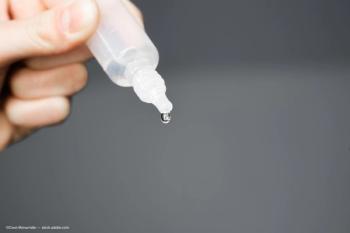
- Ophthalmology Times: June 15, 2021
- Volume 46
- Issue 10
An eye toward plateau iris and its implications
Exploring subtleties helps ophthalmologists understand postop surprises, drug reactions.
Reviewed by Sayoko Moroi, MD, PhD
Plateau iris can be an uncommon diagnostic surprise in some patients with unexpected postoperative challenges and idiosyncratic drug reactions.
Sayoko Moroi, MD, PhD, chairman and William H. Havener, MD, Endowed Professor at The Ohio State University Wexner Medical Center in Columbus, Ohio, presented surprise cases to alert physicians to the possibilities of plateau iris and what she gleaned from these patients.
Related:
Plateau iris a normal anatomic variant, ie, a ciliary body that is positioned in such a way that it physically changes the anatomy angle that can obstruct the trabecular meshwork as plateau iris syndrome (PIS), which is a form of primary angle-closure glaucoma (PACG).
According to the 2020 American Academy of Ophthalmology Preferred Practice Pattern for Primary Angle Closure (PAC), there are 6 PAC phenotypes: PAC suspect, PAC, PACG, acute angle-closure crisis, plateau iris configuration (PIC), and PIS.
These differ depending on the degree (or absence) of iridotrabecular contact, presence or absence of anterior synechiae, and the IOP and optic nerve status.
Plateau iris is also a relatively common disorder that occurs in patients with narrow angles treated with laser iridotomy and in patients without glaucoma. PIC occurs more often in hyperopic than myopic eyes.
Anterior chamber (AC) examination may show a shallow or moderate-depth AC, but the iris may “drape” the crystalline lens, with a narrow peripheral AC.
Gonioscopy shows a flat central-mid iris, an iris root that has a steep approach into the angle, and a double hump sign.
Related:
High-resolution ultrasound or ultrasound biomicroscopy (UBM), Moroi’s preference, has the advantage of visualizing the entire lens and ciliary body compared with anterior-segment
Cases
Case 1 was a 60-year-old man with healthy eyes with 20/15 bilateral uncorrected visual acuity (VA); the right and left eye IOPs were 14 and 11 mm Hg, respectively, and the angles were open with no sign of iris plateau.
In the study in which the man participated as a healthy control, acetazolamide was administered orally.
The next day his VA was 20/25 bilaterally, IOPs were 36 and 35 mm Hg, and the angles were closed. UBM showed a shallow AC, iris draped over the lens, and appositional angle closure.
A longitudinal view showed a ciliochoroidal effusion, and a B-scan showed a shallow posterior choroidal effusion.
Related:
The patient was diagnosed with an acetazolamide-induced ciliochoroidal effusion; the drug was withdrawn, and timolol, prednisolone, and atropine were prescribed. Two weeks later the VA and IOPs returned to the baseline levels, according to Moroi.1
In commenting on this, she compared the appearance on UBM of typical plateau iris, in which there is a steep insertion of the iris into the peripheral angle with the ciliary processes rotated more forward with that of atypical plateau iris, in which the iris is inserted atop the ciliary processes.
Another form, PIS, is characterized by iridocorneal contact and no sulcus.
Case 2 was a 56-year-old woman who presented for an opinion about myopic refractive surprise after cataract surgery in her left eye. She was received a diagnosis of malignant glaucoma aqueous misdirection.
The VA in that eye was 20/25 with approximately 4 D of myopia and an IOP of 16 mm Hg. Biomicroscopy showed a shallow AC, patent iridotomy, and a posterior-chamber IOL with posterior synechiae on the optic. Gonioscopy showed peripheral synechiae to the scleral spur and a PIC.
Related:
The VA in the right eye was 20/20, with approximately 2 D of hyperopia and an IOP of 16 mm Hg. Biomicroscopy showed a deep, quiet AC; patent iridotomy; and a clear lens. Gonioscopy showed the angle open to the trabecular meshwork and PIC.
A snapshot of the patient’s recent ocular history showed IOPs in both eyes that were uncontrolled; after attempts at control with various procedures, pars plana vitrectomy was performed bilaterally.
Ultimately, Moroi recognized the plateau iris, and she released the posterior synechiae on the optic, placed a capsular tension ring, and performed endoscopic cyclophotocoagulation (ECP) in the patient’s left eye.
After this intervention, her refraction was plano, as the effective optic position was in the proper plane. The patient refused this treatment in the right eye in favor of corrective lenses.
Related:
Case 3 was a 71-year-old woman with open-angle glaucoma who had undergone an uncomplicated phacoemulsification with a single-piece IOL with square haptics implanted in the capsular bag of her right eye.
Postoperatively, she had 5 months of ocular pain, blurred vision, and elevated IOP, despite multiple attempts to taper steroids. The VA in the right eye was 20/25 and the IOP was 29 mm Hg.
Slit-lamp evaluation showed trace cells, no transillumination defects, and haptics within the capsular bag. Gonioscopy showed PIC, and a fundus evaluation showed mild cystoid macular edema.
UBM showed ciliary processes that were rotated forward, the iris was directly on top of the ciliary process, and the angle was open—all consistent with a plateau iris.
UBM also identified what Moroi referred to as “haptic herniation,” by which the square haptic of the IOL compressed the ciliary processes.
Related:
The capsular bag over the haptic was seen to be fibrotic on endoscopy during surgery. Because an IOL exchange was considered too dangerous with this fibrosis, Moroi performed ECP to shrink the ciliary processes away from the haptic.
Observation
Because of her experience with plateau iris, Moroi observed that patients with a plateau iris may have a smaller interplicata diameter compared with controls.
In a study2 of 19 healthy control eyes and 37 eyes with plateau iris, 13 of whom had angle-closure glaucoma, Moroi and colleagues measured the horizontal and vertical interplicata diameters and found that the mean horizontal and vertical interplicata diameters were much smaller in PIC and PAC compared with the controls.
“In eyes with PIC and PIS with smaller IPDs, a single-piece
Moroi’s presentation has several takeaways.
She noted that the iris plateau can be missed if it has an atypical appearance as in case 1.
Related:
Moreover, the mechanism of acetazolamide-induced ciliochoroidal effusion may be similar to that of topiramate-induced ciliochoroidal effusion.
In a patient with a myopic shift as in case 2, plateau iris may be present.
Moroi also explained that a single-piece IOL may cause in-the-bag UGH syndrome. If PIC/PIS was identified previously, a multipiece IOL may be a better choice; if a high-power optic is needed, a single-piece IOL and a small capsular tension ring can be used to assure that the optic position is appropriate.
In addition, Moroi also noted that her thought is that the capsular tension ring places “horizontal tension” on the capsular bag and minimizes potential touch between the square haptics of a single-piece IOL and the anteriorly rotated ciliary processes.
Lastly, plateau iris is a normal anatomic variant (approximately 20% to 30% of eyes) and can have clinical consequences due to variation in the ocular biometry measurements.
--
Sayoko Moroi, MD, PhD
e:[email protected]
This article is adapted from Moroi’s presentation at the Ohio Ophthalmological Society 2021 virtual annual meeting. She has no financial interest in this subject matter.
--
References
1. Man X, Costa R, Ayres BM, Moroi SE. Acetazolamide-induced bilateral ciliochoroidal effusion syndrome in plateau iris configuration. Am J Ophthalmol Case Rep. 2016;3:14-17. doi:10.1016/j.ajoc.2016.05.003
2. Garza PS, Man X, Joanna H. Queen JH, et al. Size matters for interplicata diameter: a case-control study of plateau iris. Ophthalmol Glaucoma. 2020;3(6):475-480. doi:10.1016/j.ogla.2020.06.007
Articles in this issue
over 4 years ago
VA, visual function are going the way of ocular inflammationover 4 years ago
The 2 faces of glaucomaover 4 years ago
Optic neuritis: Differentiating MS from neuromyelitis opticaover 4 years ago
Elamipretide: a mitochondrial protectorover 4 years ago
Maximizing CXL effectivenessover 4 years ago
App helps patients with cataracts have smoother surgery processover 4 years ago
Cataract surgeons on OR waste: Less is often moreover 4 years ago
Natural language processing pairs with big data curationNewsletter
Don’t miss out—get Ophthalmology Times updates on the latest clinical advancements and expert interviews, straight to your inbox.













































